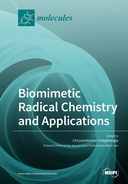Explore

Biomimetic Radical Chemistry and Applications
0 Ungluers have
Faved this Work
Login to Fave
The enormous importance of free radical chemistry for a variety of biological events, including ageing and inflammation, has attracted a strong interest in understanding the related mechanistic steps at the molecular level. Modelling the free radical chemical reactivity of biological systems is an important research area. When studying free-radical-based chemical mechanisms, biomimetic chemistry and the design of established biomimetic models come into play to perform experiments in a controlled environment that is suitably designed to be in strict connection with cellular conditions. This Special Issue gives the reader a wide overview of biomimetic radical chemistry, where molecular mechanisms have been defined and molecular libraries of products are developed to also be used as traces for the discovery of some relevant biological processes. Several subjects are presented, with 12 articles and 6 reviews written by specialists in the fields of DNA, proteins, lipids, biotechnological applications, and bioinspired synthesis, having “free radicals” as a common denominator.
This book is included in DOAB.
Why read this book? Have your say.
You must be logged in to comment.
Rights Information
Are you the author or publisher of this work? If so, you can claim it as yours by registering as an Unglue.it rights holder.Downloads
This work has been downloaded 337 times via unglue.it ebook links.
- 55 - pdf (CC BY-NC-ND) at Unglue.it.
Keywords
- 1
- 1,6-dioxa-4-azaspiro[4.5]decane
- 2-thiouracil
- 2c-3e S?S-bonded intermediates
- 5?
- 5?,8-cyclopurines
- 5]-radical translocation
- 6-dioxa-4-azaspiro[4.5]decane
- 8-cyclopurines
- 8-oxo-dG
- ?-radiolysis
- ?OH and ?N3 radicals
- albumin
- anomeric spironucleosides
- ATRPase
- azides
- azidoalkylation
- beta cells
- bio-mimicking catalyst
- bioinspired chemical catalysis
- Biology, Life Sciences
- biomimetic radical reaction
- carboazidation
- catalase activity
- cell micropolarity maps
- cellular response
- charge transfer
- chemical nuclease
- circular dichroism
- confocal microscopy
- Copper
- cross-link
- diabetes
- DNA
- DNA Damage
- DNA hole transfer
- DNA Methylation
- DNA oxidation
- DNA replication stress
- electron holes
- electron transfer
- EPR spectroscopy
- Fenton reaction
- fragmentation
- free fatty acids
- free radical oxidation
- free radicals
- gamma radiolysis
- genomic and epigenomic instability
- glycogen phosphorylase
- gold nanoparticles
- guanine quadruplexes
- Heme
- Histone Modifications
- hydrogen peroxide
- hydroxynonenal
- inhomogeneous reactions
- intercalation
- iron porphyrin
- iron(IV)-oxo
- iron-mediated ATRP
- isomerization
- Julia–Kocienski olefination
- kinetic studies
- laser flash photolysis
- lipid bilayer membranes
- lipidomics
- liposomal somatostatin
- Mathematics & science
- membrane fluidity maps
- miRNAs
- mitochondrial uncoupling protein
- modified nucleosides
- nucleobase derivatives
- nucleosides
- oligonucleotides
- oxidation
- oxidative damage
- oxidative DNA damage
- oxononenal
- peroxidation
- photo-ionization
- photolysis
- protein labeling
- protein stability
- pulse radiolysis
- quantum dynamics
- radical reaction
- Radicals
- radiosensitizers
- Raman spectroscopy
- reaction mechanism
- reactive aldehydes
- replication fork stalling
- retarded delivery
- singlet oxygen
- stationary radiolysis
- sulfones
- TD-DFT methods
- thema EDItEUR::P Mathematics and Science::PS Biology, life sciences
- therapeutic proteins
- thiobases
- thiyl radicals
- time-resolved spectroscopy
- trans lipid
- type 2 diabetes
- [1
- [1,5]-radical translocation
Links
DOI: 10.3390/books978-3-03928-393-4Editions


